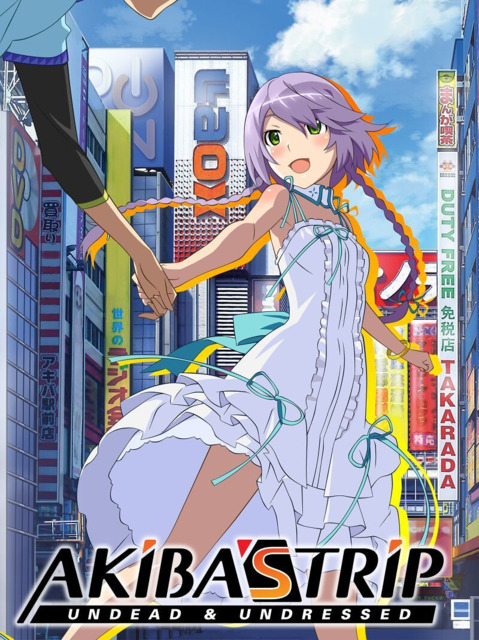Get lost in the beautifully crazy, yet humdrum, world of Akihabara
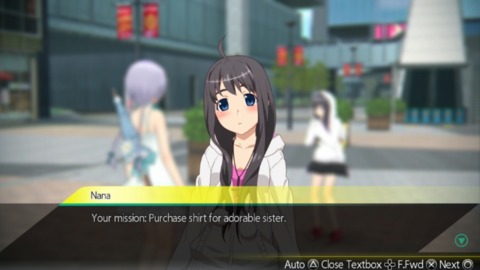
Akiba’s Trip: Undead and Undressed, like many Japanese anime-styled games, doesn’t take itself too seriously. You dress your character in crazy gender-bending outfits, strip the clothes from your foes to defeat them, and explore a part of Japan that is known for its eccentric style and frenetic energy. Thanks to developer Acquire (and localization team XSEED), players of Akiba’s Trip are given a window into the crazy world of Akihabara. For those who’ve never been to Japan, it’s a taste of what to expect. For those who have made the pilgrimage to the Land of the Rising Sun, it’s a reminder of the insanity often found there. Either way, Akiba’s Trip is a journey to another world entirely, albeit one that isn’t without some caveats.
In Akiba’s Trip, you play as an otaku (named by you) who is obsessed with collectible figurines. When he receives a mysterious email promising an employment opportunity that pays in rare figures, he can’t apply fast enough. Unfortunately for him, this offer isn’t what it seems. He is turned into a Synthister, a vampire-like being that fears sunlight and feeds on material lust and greed. Before his new nature can overwhelm him, he is saved by a mysterious young woman named Shizuku Tokikaze. Thanks to a blood pact with her, he is able to escape the mindless nature of a Synthister--but he becomes something else entirely as a result. Together with Shizuku, and friends in the AKIBA Freedom Force, he must fight to stop the Synthister threat from growing large enough to affect all of Akihabara.
The story of Akiba’s Trip is low-key. Events unfold slowly, with several “main” missions feeling like empty busywork meant to stretch the length of the game. These missions dole out plot points at a painfully slow rate. Many of the big twists are predictable if you have any amount of perception or knowledge of traditional anime tropes. The game even swaps out the supposed main villain for a new one about two-thirds of the way through, one of the more cliched elements of Japanese games. This slow, predictable pace makes the come-out-of-nowhere ending a huge shock, locking you into a tepid roller-coaster of events with no way out. As for the events of the ending, they are just as low-key as the rest of the game, petering out in a final yet boring way that I saw coming a mile away. The only bit of interesting material here is the end of your chosen romance path, where you get to see how your character and your chosen partner start a relationship.
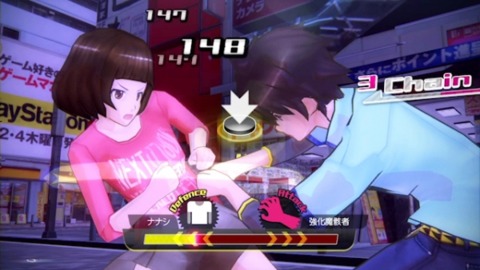
For whatever reason, however, I didn’t hate it entirely. While the plot did little to draw me in, I enjoyed the characters immensely. The cast of Akiba’s Trip is full of cliche characters and predictable lines of dialogue, but the voice acting (the English VA, at least; I didn’t sample the Japanese) and writing sold the world in a way I wasn’t anticipating. Character motivations make sense, emotions match the necessary intensity of the scenes, and I believed every bit of it, which is more than I can say about most games’ stories. I particularly enjoyed the younger sister (of your protagonist) character: she starts out very callous and introverted but opens up as the game goes on, even getting quite emotional and lovable near the end. It’s a fun set of characters that managed to keep me going when I couldn’t care less about the actual narrative.
Akiba’s Trip can be a very funny game at times. For the most part, its humor is quite strong. Several references are made to Japanese culture, often poking fun at how ridiculous it can be through lines of dialogue and events that are obviously self-aware. You fight entire 40+ person idol groups clearly meant to resemble AKB48, a hugely popular pop group in Japan. Acquire, the developer of the game, shows up in a few side missions with funny requests. Characters throw out words like “tsundere” in common speech, words which are usually reserved for real-life dissections of anime tropes. One of my personal favorite moments comes in a particular dialogue sequence. Normally, the other characters will skip over your name or use “him” or “this guy” to describe your character, a common trait in Japanese games where you enter your own name. Instead of following this trend, an NPC in one scene surreptitiously whispers the words “player character” in place of your name. It was so unexpected, perfectly breaking the fourth wall, that I couldn’t help but laugh out loud. Moments like these are peppered throughout the game, making you follow every scene intensely for the next one.
Unfortunately, it also has a lot of bad elements as well. That little sister character I mentioned has a habit of calling your character things like “bro-tagonist,” cringe-inducing lines that are (apparently) honest to the original script but still terrible. Several missions, such as those with the idol groups, have you instigating combat with people on behalf of clients who are clearly deranged or obsessive to the point of insanity. The motivations of some of these clients are skeptical and immoral, having me do things for reasons I didn’t much care for. Your dialogue choices feature some of the worst instances of poor humor in the game. Lines like “Well, excuse me, princess!” may be popular Internet memes, but their inclusion is simply lazy humor, no matter how honest to the source material they are. To be fair, the humor is more good than bad over the course of the game. Just be ready to groan once or twice.
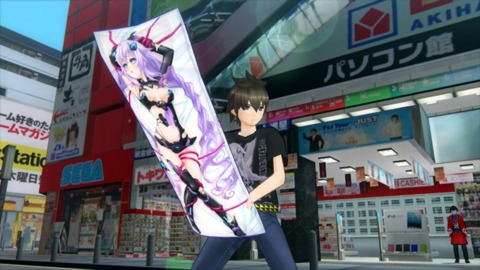
Of course, Akiba’s Trip is more than just a visual novel; for the most part, it’s a (somewhat) open-world recreation of Akihabara with missions to complete and shops to peruse. The bulk of the gameplay is the combat. You have three buttons for attacking--head, chest, and legs--with the intent of wearing down the clothes of your opponent. Once an article of clothing is weak enough, holding down the corresponding button will tear it off the opponent. Removing all outer clothing will take a foe out of the fight: either due to a Synthister dissolving in the sunlight or a normal person getting embarrassed and running away. You can also block, dodge, counter, straighten your own clothing to heal taken damage, and perform a team-up attack with your always-present combat buddy when the requisite meter has been filled. Finally, if you weaken several articles of clothing at once, you can remove them all in a Chain Strip move. In addition, doing so with enough clothing at once triggers a Strip Finish that leaves your foes completely naked, covered only by a blinding “magical girl transformation” light in place of the more sensitive bits.
Stripping your foes to defeat them is a clever idea, never ceasing to be funny. The problem is that the combat is just boring. You don’t unlock new combos or moves, instead hammering on one of the three attack buttons time and time again for every encounter. Aside from a slightly stronger enemy type near the endgame, you fight the same types of enemies over and over again. Bosses don’t do anything special, instead just taking even more hits to wear down and strip. Fights become a chore very quickly, offering little challenge and no room for style. The difficulty spikes from brain-dead easy to frustratingly difficult in large-scale encounters, when enemies gang up on your characters and bring them from full health to near-death in a matter of seconds. Long recovery periods make this even more painful, essentially stun-locking you for lengthy periods of time. The only option in encounters such as these is to play very defensively, blocking and countering whenever possible. Sadly, this is even more boring than normal combat. The tedious combat is the worst part of Akiba’s Trip. A bit more depth could have made the proposition of 8-10 hours of fighting more palatable.
Stripping the clothes off your foes also means that those clothes become a part of your inventory--if your strip skill for that type of clothing is high enough. Outfitting your character is a big part of the game, as higher levels of clothing infer more hit points for each part of your outfit. Smartly, the game has an upgrade system (via your little sister and her sewing machine) that lets you dump extra clothing into more defense on a chosen piece, letting you choose the aesthetic you prefer instead of being forced to choose something that infers more bonuses. You also equip weapons for combat, which modify the way your character attacks. Something big and heavy like a cinder block will swing slowly but powerfully, while a long broom or wooden sword has area-of-effect attacks. Likely, you will do as I did: find a weapon type you enjoy and dump all of your extra weapons into more strength on that item. It’s nice that the game lets you play as you like instead of forcing you to certain powerful gear, but it’s a bit disappointing to never receive a new piece of weaponry once you get comfortable with a certain style of fighting.
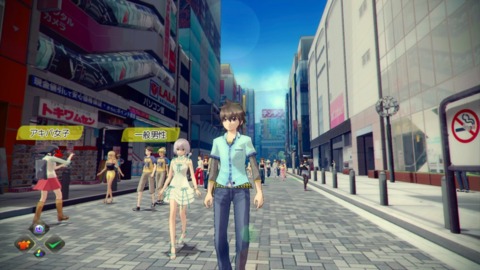
As you may expect, there is some side content to supplement the story missions. Side missions are given to you by the AKIBA Freedom Force, appearing as requests made by various civilians in Akiba. Most of them consist of finding a target, taking his or her request, and either fetching an item or fighting battles. They reward you with money and have some funny writing at times but aren’t at all necessary for progress in the game. There is an arena where you can test your battle prowess, ranking up to max level and earning bonus items and money for your successful bouts. Various stores are scattered about, letting you buy clothing and items to fill out your collection. There are even maid cafes to be visited, rewarding you with special items or temporary buffs.
The activity I found most enjoyable, however, was just basking in Akiba’s atmosphere. There are big screens everywhere, playing ads with loud music and intense Japanese voices in an attempt to catch your attention. People mill about in droves in a lively fashion, with cosplayers posing for photographs and maids attempting to lure people into cafes. Shop employees wander the streets of Akiba handing out flyers for their businesses, actual scans of real Akihabara businesses in Japan. For someone whose lifelong dream is to one day visit Japan, it’s a fantastic immersive experience that manages to both satisfy those dreams and make my heart ache even harder for that eventual visit. While the shops are little more than menus and the open-world isn’t really that open, I give Akiba’s Trip credit for attempting what it did. If anything, it proves that a true open-world game set in Japan could be quite amazing.
I played the PS4 version of Akiba’s Trip, which features a few extras. First, and most notably, is the increased fidelity in graphics and frame rate. The game runs at 1080p and with a locked 30 FPS, a much smoother experience than either the PS3 or Vita versions (from my personal experience). This also benefits the loading times, which are nearly instant, and helps the character pop-in problem found when loading into a new area in those other versions. There are also several new features. The Visual Editor is available upon starting a new game, allowing you to make changes to the graphics palette and lighting models to give the game a different stylized look. Toybox Mode, choosable from the main menu, gives you all items and unlocks at the cost of unlocking Trophies. Potentially the most interesting are the various livestreaming options given to those who watch you stream. I didn’t try this feature personally, but it promises concepts like allowing viewers to boost your health or battle gauge on the good side and calling the cops on you on the bad side. These are all small, unnecessary features, but they make the PS4 version the obvious choice if you have the option. Otherwise, the games are identical in scope and content.
Akiba’s Trip: Undead and Undressed is a goofy concept wrapped in a lovingly-rendered version of Akihabara. The game has a lot of fun with its setting and characters, putting you into situations that will have you laughing out loud at just how ridiculous or self-aware they are. Sadly, the actual gameplay doesn’t hold up as well, becoming tedious and boring long before the game is over. Your potential enjoyment with Akiba’s Trip really is up to your tolerance for repetitive gameplay. If you can’t stand games that don’t mix things up, you’ll quickly become frustrated; however, if you don’t mind a bit of repetition for the sake of a fun story set in an interesting world, give this one a shot.
